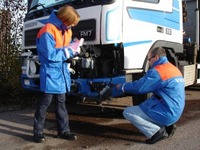The state of the ART means facts that save lives
 Over a period of four decades, Volvo Trucks’ department for accident research, the Accident Research Team (ART) has built up a unique bank of expertise that is unsurpassed in the truck industry.
Over a period of four decades, Volvo Trucks’ department for accident research, the Accident Research Team (ART) has built up a unique bank of expertise that is unsurpassed in the truck industry. “The results of ART’s work are integrated into every new safety solution that Volvo Trucks presents. Our investigations pinpoint the problems and highlight the direction for the engineers whose job it is to develop the necessary technology,” says Anna Wrige, director of the Accident Research Team.
Over the years ART has carried out more than 1,500 truck accidents investigations and this has generated a database of expertise that is invaluable in Volvo's safety work. Alongside this, co-operation with other countries and authorities has resulted in an exchange of information at an advanced scientific level. Volvo's research has thus helped boost the safety level of commercial vehicles the world over.
Focus on active safety
The purpose of the Accident Research Team's work is to improve both passive and active safety. Research into passive safety aims at ensuring the consequences of an accident are as minimal as possible, whereas active safety puts the focus on avoiding accidents in the first place.
"We've come a long way regarding passive safety in trucks, so now the focus is on active safety and the prevention of accidents. Not least because we know that the human factor lies behind as many as nine out of every ten accidents," adds Anna Wrige.
Three basic issues
In principle, the group's working methods can be explained with the help of three questions: What do the accident sequences look like? Why did the accidents happen? What can be done to prevent accidents?
"Our aim is to identify and document the main causes of accidents,” explains Anna Wrige. “This information gives us a clear picture of the major safety challenges involved in modern traffic. However, Volvo Trucks alone cannot solve these problems, so what is needed is well-developed co-operation between all the parties concerned - vehicle manufacturers, safety organisations and society."
A selection of all data
The accident team's archives contain both well-known and less well-known data, such as:
Only 10 to 15 per cent of all those killed or seriously injured in truck accidents are actually in the truck. Between 55 and 65 per cent are in cars and between 20 and 30 per cent are unprotected road users.
In a frontal impact between a truck and a car, in nine out of ten cases it is the car driver who has strayed onto the wrong side of the road.
Single-vehicle accidents, in which the truck rolls over or drives off the road, account for half of all fatalities or serious injuries in truck-related accidents.
20 per cent of all single-vehicle truck accidents are caused by driver drowsiness.
Interaction with unprotected road users
The Accident Research Team's material also includes data about many accidents that could probably have been avoided through increased interaction between the truck driver and vulnerable road users, such as cyclists and pedestrians.
As Anna Wrige says, "We have considerable responsibility for giving truck drivers the best possible all-round visibility. This is being tackled with better mirrors and cameras. However, it is also important that other road users learn to appreciate how hard it is for truck drivers to see them from their high, screened-off position."
In operation since 1969
This year Volvo's Accident Research Team celebrates its 40th ‘birthday’. Initially called the Commission for Accident Investigation, ART was founded in 1969 to investigate and increase knowledge about truck accidents involving physical injury.
Then, like today, the team members took turns at being on call to attend accident sites in the Gothenburg area of Sweden in order to investigate and document accidents. Accidents further away from Gothenburg are also studied, but only in retrospect. A key part of the investigation process is talking to the truck drivers to find out how they perceived the accident and the situation immediately preceding it. Also, because the drivers know the investigation is not linked to the official police investigation, they are often more candid in co-operating with the Research Team.
"The research initially focused on the truck's occupants. Nowadays we work from an overall perspective that includes everyone involved in the accidents we document," concludes Anna Wrige.

